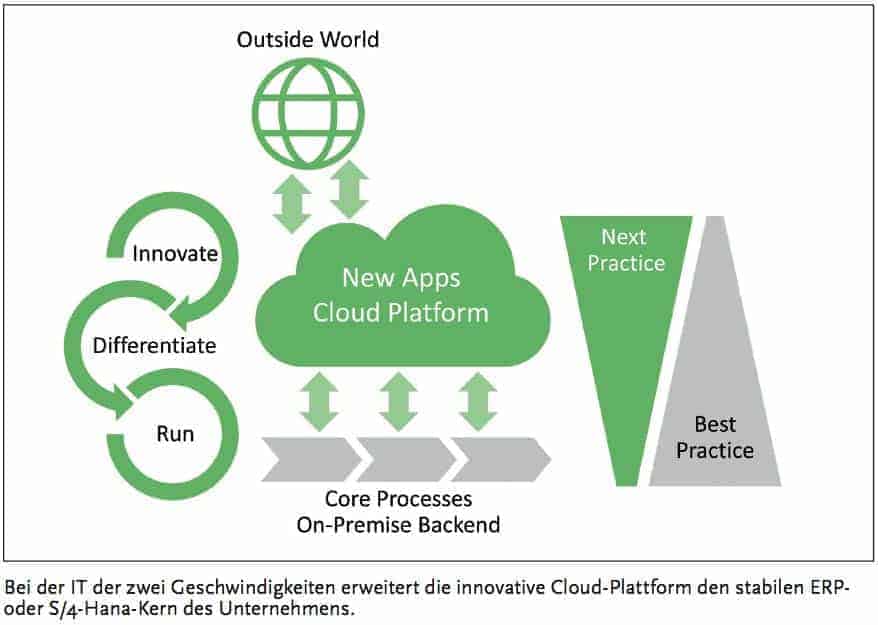The IT of two speeds


The market research firm Gartner predicts: In just a few months, three out of four companies are expected to reach profound maturity in terms of bimodal IT.
This involves a division into two parts: one area keeps the systems running, the other drives the innovations forward. This two-speed IT can be implemented technically with a hybrid system landscape: The on-premise core system is extended by a cloud platform.
For the core system, the goal is stability and operation with as little maintenance as possible. The cloud platform, on the other hand, focuses on new technologies and aims for fast, innovative apps.
From an organizational perspective, two-speed IT requires different project methodologies for core and shell to ensure successful implementation in this area of tension.
The on-premise SAP core system is intended to ensure the stability of the company's core processes. The company currently earns money with these processes; these processes are business-critical.
The stability target is the benchmark for both an old SAP ERP system and a new S/4 Hana system.
With a new S/4 Hana system, companies should seize the opportunity for a very standard SAP system and consistently eliminate old in-house developments by reverting to the SAP standard. As a result, this leads to a system that can be upgraded quickly and without great effort.
High flexibility through the cloud platform
The stable core is extended and "protected" by the cloud platform as an innovative shell. Innovations can be divided into the areas "Extend your reach, extend your scope, extend your business".
Either the outside world is the driver or companies want to open up more to the outside world through innovation. Keywords and rough scenarios for this are:
Internet of Things and Industry 4.0 as well as B2C and B2B integration. In these scenarios, companies face new challenges and risks:
24×7 availability, global access from the outside world, hard-to-predict system loads, compliance with IT standards, and avoidance of proprietary technologies.
A cloud platform is the ideal solution for these complex and multi-layered challenges. Resources and other services can be added as needed at short notice.
However, the SAP Cloud Platform (formerly Hana Cloud Platform or HCP) in particular also offers long-term advantages due to its strategic orientation. With the implementation of Cloud Foundry and Hana XS Advanced on the cloud platform and in on-premise Hana 2, SAP is relying on the "develop once, run everywhere" principle.
In the future, the deployment of an app will be cloud/on-premise independent, and moving an app from on-premise to the cloud and vice versa will be possible without any problems. This avoids strategic IT dead ends and creates investment security.
It is intended to lower the threshold for companies on the way to their own apps on the cloud platform. This bimodal principle of cloud and on-premise runs through SAP's target architecture for the future system landscape with S/4 Hana and SAP CP as the strategic architecture paradigm.
Cloud Foundry and XS Advanced are already available on-premise with Hana 2, and so will the cloud platform from mid-2017.
The new meta platform
Cloud Foundry also leads to further flexibility: For the first time in the SAP world, the BYOL ("Bring your own language") principle becomes reality. Companies can thus work with the development language of their choice: Javascript, C, Java or Phython - depending on requirements and available resources. The cloud platform thus becomes a meta-platform.
The integration of the two worlds and technical decoupling is achieved via a REST-based approach and an SAP gateway. The technology of choice is SAPUI5 with the Fiori design principle.
This makes it possible to develop contemporary user interfaces that have nothing in common with classic SAP interfaces and allow efficient use even by non-experts.
Another advantage is that large parts of the software are provided by SAP as open source.
Apps on the cloud platform can be divided into four groups: On-premise extensions add new functionality to back-end systems and processes. Stand-alone apps are not integrated into a back-end system.
Cloud extensions add new functionalities to applications in the sense of software as a service. And mobile apps are primarily intended for a mobile application.
Obviously, the app group of on-premise extensions benefits the most from this cloud/on-premise independent target architecture. This area also offers the most exciting scenarios for enterprises.
Coordinated project methodology
If you want to take advantage of these new opportunities, you need a project methodology that is tailored to them. In order to successfully establish two-speed IT, the following process models have proven themselves in cbs customer projects:
Existing stable on-premise systems with customer-specific core processes often follow traditional best-practice methodology.
The business unit gives detailed and specified requirements to the IT department, and IT delivers corresponding solutions (technical concept and implementation). The overriding goal: the ability to plan implementation and the stability of the solution.
In the innovative shell (SAP Cloud Platform), new approaches and role distributions have become established; a second, completely new IT work mode is emerging, so to speak.
Start-up mentality accelerates development
IT and the business department work on innovations on an equal footing, since IT is more familiar with the new technological possibilities and must first present them to the business department. The start-up approach within the companies has proven itself here.
The "branding" of this new approach should not be underestimated. It is important to make the new approach visible to everyone within the company as well and to emphasize its strategic importance.
The start-up approach has core methodological aspects: The concept and implementation phases are no longer separate, but merge smoothly.
The magic word is: Agile development. The aim is to achieve small and rapid iteration steps that gradually lead to a real-world solution. The IT department thus becomes the "kingmaker" for establishing new business processes.
However, the agile methods lead to new technical challenges for the team members. The business department has to get involved with new solution options, and IT has to master new topics related to the SAP Cloud Platform.
This platform relies less on proprietary technologies such as a classic SAP system and more on IT industry standards. In addition, the isolation in the cloud platform means there is no "risk of destabilization" for the on-premise backend system.
Both aspects enable new options for project staffing: previously non-SAP developers can enter the project more easily. In the process, they often bring a breath of fresh air to the SAP department. Due to the innovations, the involvement of external cloud platform experts is also recommended.
Ideally, this approach is first tested in smaller projects and established in the company, and can thus be brought to a quick and visible success.
The choice of project methodology, the use of the SAP Cloud Platform, and the specific choice of technologies must always be determined individually for each company based on the specific situation.
Experienced consultants like cbs Corporate Business Solutions offer efficient methods for this. They are able to combine management consulting for development planning and system architecture with technology services.
Next Practice and Best Practice
The conclusion from successful customer projects: Project methods proven in the on-premise backend (best practice) no longer play a role on the cloud platform. They are replaced by the "next practice" principle, which consciously accepts vagueness and imponderables at the start of the project.
The reward for this cut is applications that can be used in a short time and are truly innovative. It is never a matter of either-or of the two working modes, but always a matter of both-as well.
Agile innovation is driven in the cloud, while back-end processes form the stable core. Only the combination of both leads to successful differentiation in the market.
The steps required within the company to establish the two IT work modes are thus essential and unavoidable.
cbs has already successfully implemented fast and innovative projects with this two-speed IT model. The tension between stability and rapid innovation has been successfully resolved.







